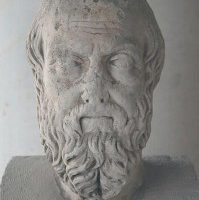Herodotus is often referred to as the “Father of History”, from his published scholarly work known as the “Histories” which is a contemporary account of the Greek world. His work does not just describe the major events but also the every day life that he observed during his travels around the Mediterranean. In the second book of the histories, Herodotus travels to Egypt where he notes down his observations of an unusual type of river barge:
The boats in which they carry cargo are made of the acacia, which is in
Herodotus Book II:Chapter 96, this version can be found here – Credit: Bill Thayerform most like to the lotus of Cyrene, and its sap is gum. Of this tree they cut logs of two cubits length and lay them like courses of bricks, and build the boat by making these two‑cubit logs fast to long and close‑set stakes; and having so built they set crossbeams athwart and on the logs. They use no ribs. They caulk the seams within withbyblus . There is one rudder, passing through a hole in the boat’s keel. The mast is of acacia-wood and the sails ofbyblus . These boats cannot move upstream unless a brisk breeze continue; they are towed from the bank; but downstream they are thus managed: they have a raft made of tamarisk wood, fastened together with matting of reeds, and a pierced stone of about two talents’ weight; the raft is let go to float down ahead of the boat, made fast to it by a rope, and the stone is made fast also by a rope to the after part of the boat. So, driven by the current, the raft floats swiftly and tows the “baris ” (which is the name of these boats), and the stone dragging behind on the river bottom keeps the boat’s course straight. There are many of these boats; some are of many thousand talents’burden .

The existence of this type of vessel has never been confirmed, until now. It was at the sunken Mediterranean port city of Thonis-Heracleion where underwater archaeologists discovered a wreck that fit Herodotus’ description of the river barge. Ship 17, now identified as

Thonis-Heracleion: A Legendary Port City
Before the building of Alexandria in 331 BC, Thonis-Heracleion served as the main gateway for maritime trade between the Ancient Greek world and Egypt. With the exception of a few references to the port, the city had long been forgotten until its rediscovery in 2000 by the European Institute for Underwater Archaeology (IEASM) directed by Franck Goddio. Since the archaeological investigations began, the city has revealed unprecedented finds, including over 70 shipwrecks, on which multiple scholarly articles and books have been published. With an estimation of only 5% of the city that has been investigated, this remarkable underwater cultural heritage site is
Sources
Belov, A. 2018. Ship 17: a baris from Thonis-Heracleion. Oxford Centre for Maritime Archaeology Vol. 10. Oxford: Oxford Centre for Maritime Archaeology
Geggel, L. 2019. 2,500 Years Ago, Herodotus Described a Weird Ship. Now, Archaeologists Have Found It. [Live Science]. Available from:
https://www.livescience.com/65028-herodotus-ship-discovered.html [Accessed on: 9th March 2019]
Goddio, F. 2019. Sunken Civilizations. [online]. Available from:
http://www.franckgoddio.org/projects/sunken-civilizations/heracleion.html [Accessed on: 9th April 2019]
Goddio, F. 2019. Publications. [online]. Available from:
http://www.franckgoddio.org/library/publications/ocma.html [Accessed on: 9th April 2019]
Lendering, J. 2018. Herodotus’ Histories. [online]. Available from:
https://www.livius.org/articles/person/herodotus/herodotus-histories/ [Accessed on: 9th April 2019]
Lendering, J. 2019. Herodotus. [online]. Available from:
https://www.livius.org/articles/person/herodotus/ [Accessed on: 9th April 2019]
Mark, J. J. 2018. Herodotus. [online]. Available from:
https://www.ancient.eu/herodotus/ [Accessed on: 9th April 2019]
Thayer, B. 2018. Herodotus Book II: chapters 1-98. [online]. Available from:
http://penelope.uchicago.edu/Thayer/E/Roman/Texts/Herodotus/2A*.html [Accessed on: 9th April 2019]


